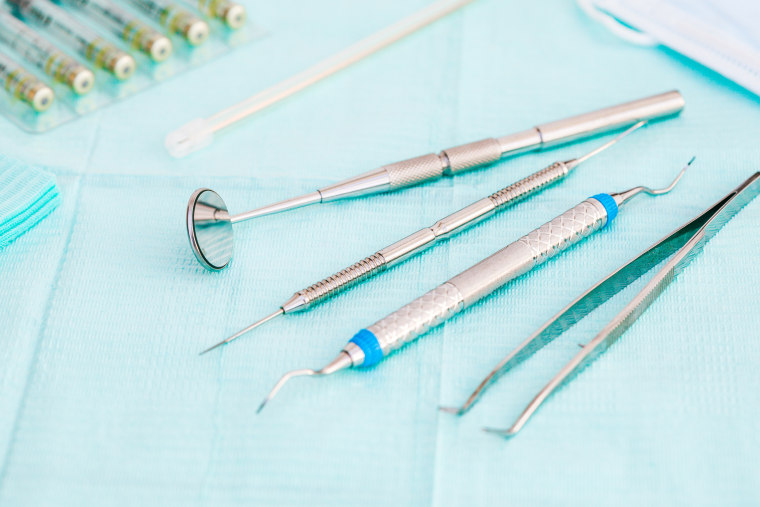More than 14 million adults across the United States who receive Medicaid are at risk of losing dental health coverage now that the Covid public health emergency is over, according to data exclusively obtained by NBC News.
The public health emergency ended April 1, allowing states to review Medicaid recipients’ eligibility and disenroll them from the program for the first time since the beginning of the pandemic. Around 15.7 million people are expected to lose health coverage as a result. The emergency declaration did not allow states to remove enrollees from the program during the pandemic, which caused programs to expand precipitously over the past three years.
An issue that few have identified, however, is that about 14.2 million people, or 28% of adults currently enrolled in Medicaid, will also lose their dental health coverage, according to the data compiled by CareQuest Institute for Oral Health, a think tank dedicated to oral health in the country.
The five states facing the biggest drop in coverage are Hawaii, Wyoming, Indiana, Florida and Illinois. While many states offer very limited forms of dental coverage through Medicaid, Texas is the only state program with no coverage at all. It is expected to be a huge effort for state agencies to contend with the redetermination of people's Medicaid eligibility.
Dr. Myechia Minter-Jordan, the president and CEO of the think tank, said her group felt compelled to compile and release the data to ensure that states and public health agencies help people maintain their oral health care coverage.
“As people are removed from Medicaid and seek to secure coverage through other programs, including the private market, there’s no guarantee that they will know to seek or know how to apply for coverage that will include dental care,” she said. “And this will have a disproportionate impact on those who are lower income, live in rural areas or people of color.”
As many as 47 states give some form of dental health coverage to Medicaid recipients, providing either emergency care, limited coverage or extensive dental services. The loss of care could have an outsize effect on communities of color. About 25% of adults with Medicaid see a dentist annually, according to the Centers for Medicare and Medicaid Services, though it can be difficult to find a dentist who accepts Medicaid.
Those sounding the alarm about the issue point to numerous studies that link poor dental hygiene with a person’s overall health. These links have become a rallying cry for many in the dental world in recent decades, as a landmark U.S. surgeon general study published in 2000 found that a person’s oral health could put a person at greater risk for health issues.
Beyond those risks, poor dental health can also affect a person’s self-image and ability to obtain work, said Dr. Lisa Simon, a physician and dentist at Brigham and Women’s Hospital and Harvard School of Dental Medicine.
“It affects how you feel about yourself, how you communicate with others, your ability to take in nutrition, how much pain you experience each day and possibly your sense of self when you look in the mirror,” she said. “There is pretty good data that shows that people who have less access to dental care, particularly in childhood, often earn less money in adulthood because the way our appearance can affect our mental health and the perception others have of us.”
Dental health issues affect most adults in the U.S. Only 48% of people between the ages of 20 and 64 had a full set of permanent teeth, according to a 2015 Centers for Disease Control and Prevention study.
But preventative dental care can keep people from emergency room visits, saving patients, hospitals and states from costly ER care. States have to balance that long-term cost saving, however, with the potential immediate savings to state and federal budgets by slashing dental coverage.
Medicaid and Children's Health Insurance Program (CHIP) expenditures for dental services grew from $14.9 billion in 2020 to $17.8 billion in 2021, according to the Centers for Medicare and Medicaid Services, though the amount spent on dental services from the total Medicaid expenditure stayed about the same — growing only from 2.2% to 2.4%.
But people are also spending more on dental issues than ever before. Dental expenditures in the U.S. have ballooned from $95 billion in 2000 to $162 billion in 2021, according to the American Dental Association.
More than half wasn’t paid by insurance companies in 2021 but instead was paid for by a combination of out-of-pocket costs and supplemental government programs. Out-of-pocket costs constituted about $63 billion in 2021 and government programs covered about $25 billion.
Still, a 2014 National Institutes of Health study found that cuts to dental benefits during the 2008 recession led to increased use of emergency departments. And yet, it’s often the first budget item that states consider cutting.
“States have really only expanded dental coverage in the recent past,” Simon said. “After the recession, there were huge cuts to Medicaid dental benefits, and in subsequent economic downturns it is often the first thing on the chopping block in state legislatures.”
The need is there. According to a CareQuest Institute report last year, 55% of adults reported some type of oral health problem, more than half of adults with a problem did not seek care and 27% did not seek care because they could not afford it.
Minter-Jordan said she hopes that governments will be more proactive to ensure there are opportunities to continue coverage, and she emphasized that Medicaid beneficiaries should check their coverage.
“We really want to make sure that people understand — that the agencies, the federal and state governments understand — the cost of not providing oral health care,” she said. “That’s really key.”
CORRECTION (April 21, 4:55 p.m. ET): An earlier version of this article misstated the number of states that don’t offer dental coverage as part of their Medicaid plans. There is only one state, Texas, not a total of six.

